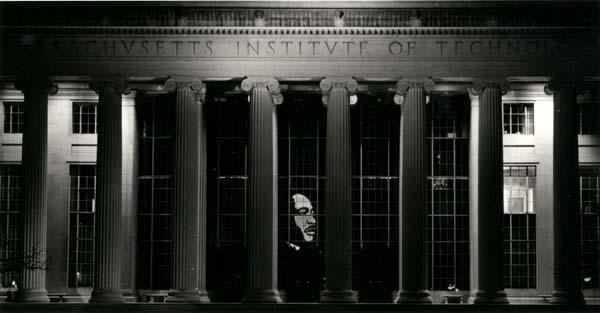2002 IAP MLK Seminar

View from Killian Court of MLK Design Seminar Exhibit in Lobby 10, 2002. Source: Tobie Weiner, Will Lark
Artist Statement
In today’s politically correct world we are led to believe that we live the dream of total equality and justice, however, this has not yet been realized. Our installation is a reminder of the contradiction that exists between today’s reality and the ideal we strive to achieve. It celebrates the continuing struggle for Civil Rights that will bring Dr. King’s dream to fruition. This dream is not physical socioeconomic brutality. It is not insidious exclusion and disrespect. The path to the dream has been darkened by hatred and ignorance throughout the history of this country, but it is illuminated by the love and wisdom of the many proponents of justice our nation has seen. The MIT community forms an important element of the social and technical vanguard, and with this position comes the great responsibility of helping to lead the struggle. The installation in lobby 10 (seen above from Killian Court) is both a call to action and a commemoration to one of America’s greatest leaders.
Dr. Martin Luther King Jr. Design Seminar
Professor Tobie Weiner, Will Lark
Students work on MLK art installation
Robert J. Sales, MIT News Office, 20 January 2002
Forty-two MIT and Wellesley College students are working on three projects as part of the Dr. Martin Luther King Jr. IAP Design Seminar. The event culminates in an artistic installation to coincide with MIT’s annual celebration of the life and legacy of Dr. King.
The three-part installation, which will be on display in Lobby 10 from Friday through Feb. 10, provides a forum for the students to express their thoughts on civil and human rights, racism, justice and the principles of Dr. King. Alexandra Awai, a sophomore in biology, and Raymond Morales, a senior in electrical engineering and computer science (EECS), are directing the group.
“In today’s politically correct world, we are led to believe that we live the dream of total equality and justice; however, this has not yet been realized,” says their theme statement. “Our installation is a reminder of the contradiction that exists between today’s reality and the ideal we strive to achieve. It celebrates the continuing struggle for civil rights that will bring Dr. King’s dream to fruition.”
About 10 students in the seminar have been reading books about Dr. King and civil rights to elementary school children at the Cambridge Community Center. This group plans to create a photo mosaic that will be part of the installation. They are working under the direction of John Pope, a sophomore in EECS.
Another group, directed by Terrence Strader (also a sophomore in EECS), is creating a slide show and video. They will discuss race and equality at a forum tonight from 6-8 p.m. in Room 4-231.
The overall student leader for the class is Will Lark, a junior in mechanical engineering. The instructor is Tobie Weiner, undergraduate administrator in the Department of Political Science.
The students watched “Eyes on the Prize” videos and discussed the issues and concerns of Dr. King and the civil rights movement before embarking on their projects.
MLK piece evokes conflict between reality and ideal
Sarah H. Wright, MIT News Office, 6 February 2002

The dramatic installation in Lobby 10 honoring the life, work and memory of Dr. Martin Luther King Jr. combines a larger-than-life silhouette portrait of Dr. King with posed, life-sized manikins and a path into a “minority circle” designed to guide viewer/participants in seeing both the dream and the historical realities of race relations in America.
The installation is the product of the IAP Martin Luther King design seminar led by Tobie Weiner, undergraduate administrator in the Department of Political Science, in collaboration with students. It runs through Sunday, Feb. 10.
Weiner summarized the students’ goals in creating the MLK installation as reflecting “both the ideals of Dr. King as well as their own struggles and dreams.”
The student designers said in a collectively written statement, “In today’s politically correct world, we are led to believe that we live the dream of total equality and justice; however, this has not yet been realized. Our installation is a reminder of the contradiction that exists between today’s reality and the ideal we strive to achieve. It celebrates the continuing struggle for civil rights that will bring Dr. King’s dream to fruition.
“The path to this dream has been darkened by hatred and ignorance throughout the history of this country, but it is illuminated by the love and wisdom of the many proponents of justice our nation has seen. The MIT community forms an important element of the social and technical vanguard, and with this position comes the great responsibility of helping to lead the struggle. The installation in Lobby 10 is both a call to action and a commemoration of one of America’s greatest leaders.”
The students who participated in the MLK design seminar are holding a forum tonight from 7 to 9 p.m. in Room 4-370 to show one of the videos they made in the seminar and to discuss race relations.
The 28th annual breakfast celebrating Dr. King’s life and legacy will be held this Friday, Feb. 8 at 7:30 a.m. in Morss Hall in Walker Memorial. This year’s speaker is television correspondent, author and political commentator Tavis Smiley. He will speak on the theme of this year’s celebration, “From Dreams to Reality: The Illusion of Full Inclusion.”
A version of this article appeared in MIT Tech Talk on February 6, 2002.

